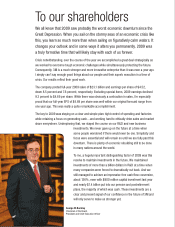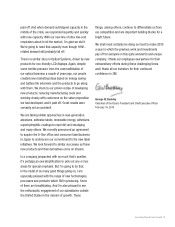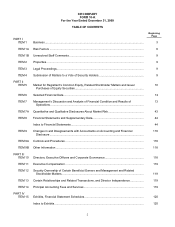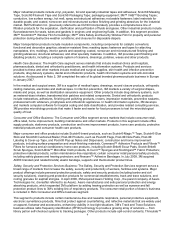3M 2009 Annual Report Download - page 12
Download and view the complete annual report
Please find page 12 of the 2009 3M annual report below. You can navigate through the pages in the report by either clicking on the pages listed below, or by using the keyword search tool below to find specific information within the annual report. 6
various countries where patent protection is obtained. The actual protection afforded by a patent, which can vary
from country to country, depends upon the type of patent, the scope of its coverage and the availability of legal
remedies in the country.
The Company believes that its patents provide an important competitive advantage in many of its businesses. In
general, no single patent or group of related patents is in itself essential to the Company as a whole or to any of the
Company’s business segments. The importance of patents in the Display and Graphics segment is described in
“Performance by Business Segment” — “Display and Graphics Business” in Part II, Item 7, of this Form 10-K.
Raw Materials
In 2009, the Company experienced cost decreases in most raw materials and transportation fuel costs. This was
driven by lower basic feedstock costs, particularly metals and oil derived materials. To date, the Company is
receiving sufficient quantities of all raw materials to meet its reasonably foreseeable production requirements. It is
impossible to predict future shortages of raw materials or the impact any such shortages would have. 3M has
avoided disruption to its manufacturing operations through careful management of existing raw material inventories
and development and qualification of additional supply sources. 3M manages commodity price risks through
negotiated supply contracts, price protection agreements and forward physical contracts.
Environmental Law Compliance
3M’s manufacturing operations are affected by national, state and local environmental laws around the world. 3M has
made, and plans to continue making, necessary expenditures for compliance with applicable laws. 3M is also
involved in remediation actions relating to environmental matters from past operations at certain sites (refer to
“Environmental and Other Liabilities and Insurance Receivables” in Note 14, Commitments and Contingencies).
Environmental expenditures relating to existing conditions caused by past operations that do not contribute to current
or future revenues are expensed. Reserves for liabilities for anticipated remediation costs are recorded on an
undiscounted basis when they are probable and reasonably estimable, generally no later than the completion of
feasibility studies or the Company’s commitment to a plan of action. Environmental expenditures for capital projects
that contribute to current or future operations generally are capitalized and depreciated over their estimated useful
lives.
In 2009, 3M expended about $15 million for capital projects related to protecting the environment. This amount
excludes expenditures for remediation actions relating to existing matters caused by past operations that do not
contribute to current or future revenues, which are expensed. Capital expenditures for environmental purposes have
included pollution control devices — such as wastewater treatment plant improvements, scrubbers, containment
structures, solvent recovery units and thermal oxidizers — at new and existing facilities constructed or upgraded in
the normal course of business. Consistent with the Company’s policies stressing environmental responsibility, capital
expenditures (other than for remediation projects) for known projects are presently expected to be about $22 million
over the next two years for new or expanded programs to build facilities or modify manufacturing processes to
minimize waste and reduce emissions.
While the Company cannot predict with certainty the future costs of such cleanup activities, capital expenditures or
operating costs for environmental compliance, the Company does not believe they will have a material effect on its
capital expenditures, earnings or competitive position.
Executive Officers
Following is a list of the executive officers of 3M, and their age, present position, the year elected to their present
position and other positions they have held during the past five years. No family relationships exist among any of the
executive officers named, nor is there any undisclosed arrangement or understanding pursuant to which any person
was selected as an officer. This information is presented as of the date of the 10-K filing (February 16, 2010).
























